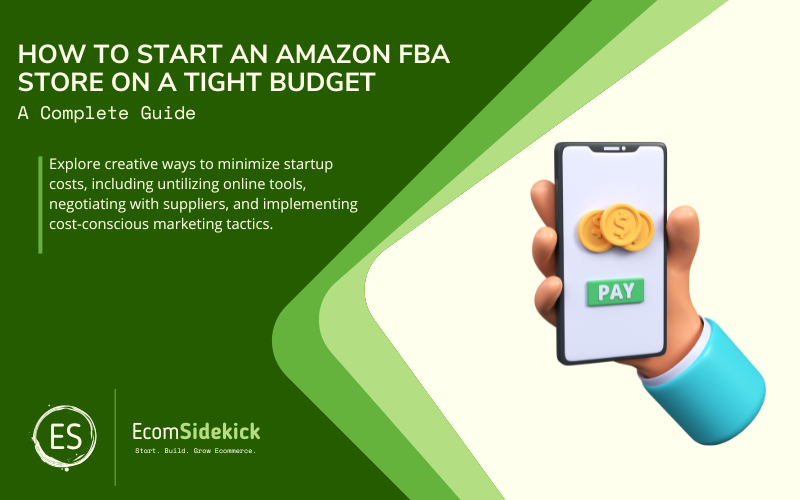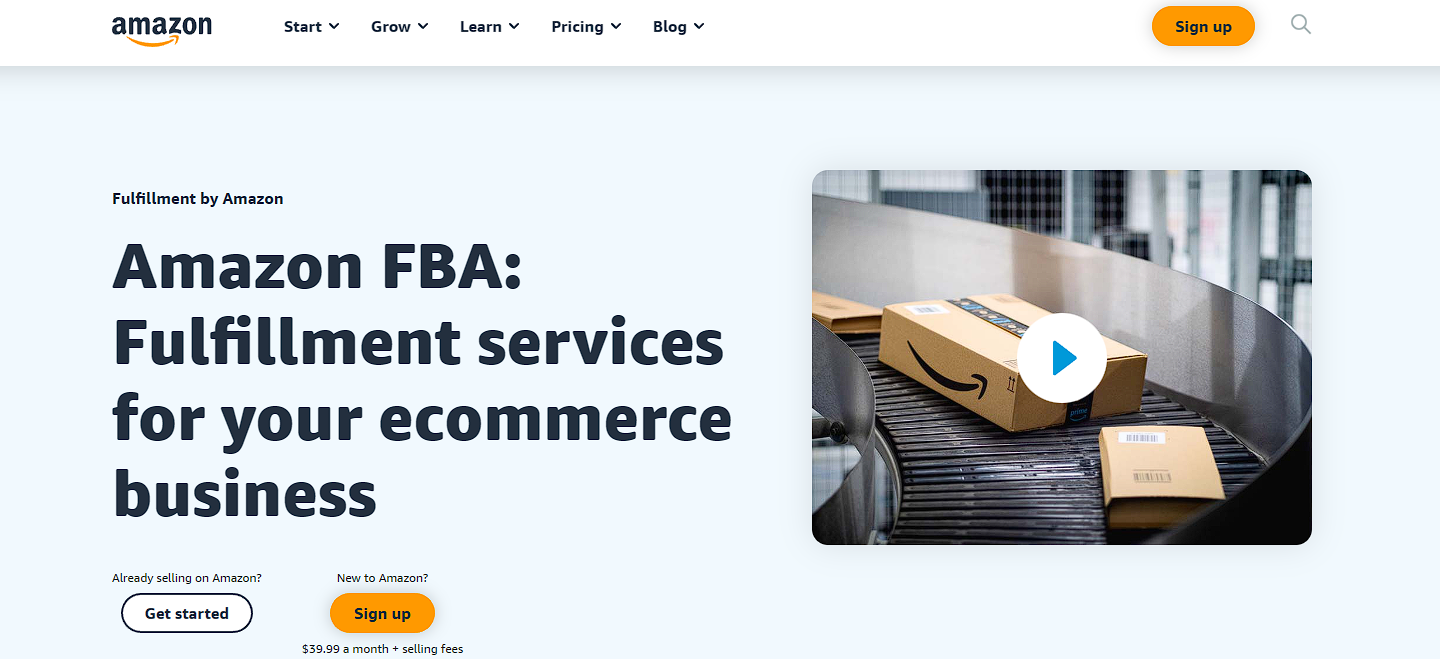An Amazon FBA store is an online selling platform that allows entrepreneurs to leverage the power of Amazon’s fulfillment infrastructure. With Amazon FBA (fulfilled by Amazon), you can list your products on Amazon and send your inventory to an Amazon warehouse. But how to start an amazon FBA store on a tight budge? This article will help you in this matter.

Customers who order from an Amazon FBA store get the same fast, free shipping they would expect if they placed the order themselves directly on Amazon. An Amazon seller typically handles marketing, customer service, and product selection while letting Amazon do most of the heavy lifting with storing, packaging, and shipping orders. It’s an efficient way for sellers to save time and money while scaling quickly yet responsibly.
Adopting the Amazon marketplace is an excellent way for entrepreneurs to reap the benefits of selling on what is often known as one of the world’s largest online marketplaces. Today, we’re looking into the entire process of setting up your Amazon FBA store, following a step-by-step guide that will help you start with this online selling platform with as little initial investment as possible, and avoid costly mistakes, even if you are a complete beginner.
How Much Money Do You Actually Need to Get Started at Amazon FBA?
Starting an Amazon FBA store with a tight budget can be done. However, there are significant advantages to starting with more money. For example, more money would give you better access to resources like product inventory and competitive pricing tools.
Starting a business as an Amazon seller requires an upfront investment of money and resources. The money you will need to get started depends on the type of product you are selling, the quantity, and other factors such as shipping costs and storage fees if we are talking about physical products.
Generally speaking, beginning the Amazon FBA process with as little as $500-1,000 invested into sourcing your products from wholesalers or manufacturers is possible.
If you choose to manufacture your own products, your start-up costs could increase depending on your product type. For example, materials, molds, etc., customs/tariffs/import taxes, and additional inventory costs might also come into play.
In addition to investing in product sourcing, shipping costs may be higher than expected. It’s a good idea to factor in potential overseas shipping expenses when budgeting your startup costs.
Another relevant factor to consider is storage fees, which vary according to the size and weight of the items you store in an FBA warehouse. Longer-term storage fees will be higher due to having to pay rent for their space over time.
Depending on how much inventory you plan on stocking at once can significantly impact your overall startup costs.
Ultimately, the amount of money needed to get started at Amazon FBA varies depending upon many factors, such as the cost associated with product sourcing and producing; however, one can typically begin with a basic budget between $500-$1,500 depending upon specific product criteria.
How to Start an Amazon FBA Store on a Tight Budget: Step-By-Step

There are eight essential steps to make you a successful seller on your own Amazon FBA store:
Step #1 – Research Your Product
Researching profitable items to sell on an Amazon FBA store is essential to ensure successful sales and great profit margins. Before settling on a product idea or launching a new product line, you should conduct market research to understand consumer demand and discover potential competitors.
To begin the research process, define the target customer you want to reach and assess your product’s needed features compared with competitor offerings.
Next, you should uncover what specific keywords your customers might be using when searching for similar products. You can do that by conducting keyword searches related to your product, looking into Amazon’s Best Sellers section, and competitor listings.
You can also research marketplaces such as Alibaba to find out hot-selling items with huge demand. Additionally, social media fan pages can provide helpful feedback about popular trends or ideas for creating one-of-a-kind products that customers may have yet to see but are interested in learning more about.
Alongside analyzing competitors, as an FBA professional seller, you need to get accurate data about how much inventory you need to order and how often orders need to occur. It would be best if you also considered whether the cost of shipping from your source country is higher than buying from closer suppliers within Europe or America.
This all depends on where your target customers live and other factors related to geography. Furthermore, when sourcing private label items, you must research lithium battery shipping regulations such as those enforced by FedEx or UPS before making purchases.
Finally, conducting thorough research allows FBA retailers to create successful pricing strategies based on competition levels or scarcity. Suppose there is a little-to-no competition offering similar items at lower prices. In that case, you can set prices accordingly while remaining competitive within your category simultaneously.
Researching your product before launching an Amazon FBA store helps ensure its success. Finding profitable markets and knowing customer needs and pricing strategies will help build your brand’s presence!
Step #2 – Create a Business Plan
Creating a business plan is essential to starting an Amazon FBA store. A business plan is a document that outlines the overall vision and goals for the company, as well as strategies to achieve them. It also serves to provide structure, clarity, and confidence when it comes to launching and running a new venture.
A business plan helps entrepreneurs define their target audience and identify a viable market for their products or services. This will allow you to position your product offerings in a way that attracts potential customers and establish a competitive advantage within the industry.
Additionally, having high-level objectives in a business plan ensures that all efforts are focused on achieving these goals, helping founders stay motivated during difficult times and make better decisions regarding expanding rapidly or entering new markets, etc.
Business plans also help entrepreneurs source funding from investors by providing financial projections of future income streams and other costs they need to meet to operate successfully.
Having this key document can also encourage collaboration amongst different teams, such as marketing, sales, customer service, etc., due to its ability to act as a roadmap for onboarding new employees or setting tasks for existing team members so that everyone is aware of what needs to be done at each stage of launching/growing an Amazon FBA store.
In conclusion, creating a business plan for any startup venture is highly important because it provides direction on what resources are needed and how best to reach success. Therefore, taking the time out to create one pays off significantly when starting an Amazon FBA store.
Step #3 – Source Suppliers
Sourcing suppliers for your Amazon FBA store is crucial when starting an e-commerce business. Identifying reliable and trustworthy suppliers who can provide quality products at competitive prices is essential to ensure that you’re selling the best-possible items on Amazon.
Here are a few tips on how to source suppliers for your Amazon FBA store:
- Research: Research potential suppliers, product offerings, and prices. Compare the options available and narrow down your list of potential suppliers before making contact.
- Network: Build relationships with potential suppliers by attending industry trade shows or virtual events and leveraging your professional contacts in the industry. This will help you better understand how they operate, their services, and which ones may work best for you.
- Safety: Carefully review supplier credentials, such as certifications or licenses, to ensure they are legitimate and compliant with relevant regulations. This will ensure that your business meets all standards for sourcing supplier goods and services ethically and responsibly
- Reputation: Looking up references from third-party websites like Yelp or Google Reviews helps determine customer experiences with each supplier. This way, you can gauge which one may be the most reliable based on feedback from customers who have previously worked with them.
- Negotiations: Once you have identified a few potentially good-fit suppliers, reach out to them directly via email or phone to build relationships with those responsible for dealing with buyers. This way, you can negotiate more favorable terms on pricing and delivery.
- Contracts: Before finalizing any agreements, make sure that both parties sign contracts outlining all details involved, including product quantities being purchased, payment terms, acceptable levels of quality control criteria as well as agreed upon legal responsibilities.
Step #4 – Create Your Amazon Account
Creating an Amazon account is essential to setting up a successful Amazon FBA business. To create an Amazon account, you must provide basic information such as your name, address, email address, and telephone number. You will also need to choose a password that meets the requirements of Amazon’s security standards.
Once your account is created, you must set up payment methods such as credit cards or bank transfers and select a tax plan. This process can take several days but is necessary to run an online business. After completing this step, you will have full access to the seller portal, where you can start listing products, managing inventory, and shipping orders.
It’s important to note that before creating an Amazon account, some basic research needs to be done to determine which plan best fits the scope and scale of your business goals.
Additionally, most FBA sellers will require additional services to succeed, such as product photography and website design. It’s essential to factor in these costs when budgeting for your Amazon FBA business setup.
Step #5 – Develop Your Brand Image
When developing a brand image for your Amazon FBA Store, you should take five simple steps. First, identify the mission and values of your business and the type of product you’re selling. These elements will become crucial to communicating with customers throughout their shopping journey.
Second, create an eye-catching logo representing your store and following Amazon’s guidelines. This logo will be used in all promotional efforts and help to build a recognizable and memorable identity over time.
Third, focus on optimizing your store’s physical and digital aspects. Design a brief listing page with images, videos, descriptions, and reviews about each product. This can help nudge shoppers towards taking the desired action of converting into customers. Incorporate design elements like fonts and colors throughout your landing page, which echo those seen in the logo.
Fourth, cultivate relationships with customers by providing top-notch customer service, including quickly answering inquiries from potential or existing customers or offering special discounts or promotions to loyal shoppers. Promote customer engagement by creating targeted email marketing campaigns or engaging with them on social media platforms such as Instagram, Facebook, or Twitter.
Lastly, ensure your content – blog posts or YouTube videos – is always relevant to customers’ needs while aligning with what they expect from a brand associated with your particular product niche. By embracing these tips, you can quickly develop a strong brand image for your Amazon FBA Store. This will build loyalty over time among your target audience, leading to higher conversion rates in the foreseeable future!
Step #6 – Build Your Online Presence
Building an online presence for an Amazon FBA store can be daunting. Still, it is essential if you want to succeed in the fiercely competitive world of e-commerce. Here are a few steps that you can take to build an effective online presence and boost your store’s visibility:
- Create a Website: A website is a great way to showcase your product inventory, tell customers about your business, and provide helpful information about ordering and delivery. Your website should be optimized for SEO (Search Engine Optimization) to appear at the top of major search engines such as Google when customers search for relevant keywords related to your offer. Additionally, consider setting up a blog on your website where you can post content related to topics of interest in your industry. This will further increase your store’s visibility.
- Leverage Social Media Platforms: Social media platforms like Facebook and Instagram are powerful marketing tools that allow businesses to reach large numbers of potential customers quickly and easily. By creating rich visual and shareable content posts, your business can engage with your audience in meaningful ways and reach new audiences who may have yet to be aware of your products or services. You can also use targeted ads on popular social media platforms to direct relevant traffic to your website and FBA store.
- Have an Active Presence on Popular Forums & Communities: An active presence in popular forums or communities such as Reddit or Quora allows your business to answer people’s questions about your products or services and interact with current customers. This helps promote brand recognition, credibility, and trustworthiness, which are all critical aspects of maintaining customer loyalty and boosting sales over the long term.
- Optimize Your Amazon Listings: When listing products on Amazon, make sure they are clearly labeled with accurate information, including high-resolution images and detailed descriptions that accurately reflect the quality of what you’re offering, plus any additional features or benefits associated with them. Having a perfect listing will ensure prospective buyers know exactly what they’re getting before clicking “add-to-cart,” boosting conversion rates significantly!
These steps will help create solid foundations for building an online presence for your Amazon FBA store. Following them will attract more customers and boost sales over the long term!
Step #7 – Prepare Products for Distribution to Customers
Preparing products for distribution to customers in an Amazon FBA store is essential to the overall order fulfillment process. Before shipping out products, several steps must be taken to ensure that customers receive their orders promptly and in excellent condition.
All items must be professionally packaged and carefully labeled with accurate customer information such as the address, name, and order number. Packages should also include a packing slip or other form of customer communication and any promotional material related to the purchase. All orders must be weight verified and labeled appropriately according to regional or international regulations before being sent.
The next step is ensuring that all items are tested, inspected, and functioning correctly before shipment. This includes checking that battery-operated devices are charged and ready for use and contain any electrical components on oversized items like televisions or appliances. Additionally, each article should be thoroughly cleaned so that it arrives looking new and presentable to customers.
Finally, product models should continuously be updated so customers can reference the correct product numbers during the ordering process.
Keeping product models updated also helps FBA stores stay abreast of changing Amazon policies related to returns, warranties, etc. This allows them to prepare for possible exchanges or refunds when needed.
Following these guidelines will help ensure that all products are shipped out in perfect condition and arrive at their destination on time for customer satisfaction. It is a crucial step for successful Amazon FBA stores!
Step #8 – Monitor & Optimize Strategy as Needed
Monitoring and optimizing the strategy of an Amazon FBA store is essential to remain competitive in the e-commerce market. It is crucial for online businesses to analyze data continuously and adjust plans as needed.
One way to monitor and optimize your Amazon FBA strategy is by analyzing search terms related to your product or service. Keep track of trends related to your searches and optimize accordingly, whether that means adjusting keywords or increasing pricing. It is also essential to consider customer reviews and feedback, which can provide valuable insight into how customers perceive your products or services.
It is also essential to monitor your campaigns’ performance by analyzing each campaign’s results. Pay attention to metrics such as click-through rate, conversion rate, return on investment, cost per acquisition, etc., so you can accurately assess which tactics benefit your business. This will help you determine what areas need improvement so you can make necessary changes or fine-tune existing strategies for better results.
Using tools such as AdWords or other analytics platforms will also be beneficial in monitoring and optimizing campaigns by understanding how well they’re performing. This data can then be broken down into detailed reports, which provide an in-depth look at the various components making up a successful campaign, such as keyword optimization, calls-to-action used, ad positioning, etc., allowing you to make necessary changes if needed.
In addition to this analysis, it is also worth considering A/B testing different aspects of campaigns to find the right balance that is both successful and profitable for your business in the future.
To summarize, monitoring and optimizing a strategy for an Amazon FBA store requires continuous time and effort while staying up-to-date with market trends related to equivalent products or services offered online.
By leveraging available data sources such as customer reviews & feedback along with analytical tools like AdWords & analytics platforms, adjustments can be made based on campaign performance results, allowing businesses to use optimized strategies designed for their specific e-commerce needs.
Final Thoughts

Starting an Amazon FBA store with a limited budget is possible. Still, it will take dedication and hard work. You’ll need to focus on researching and selecting the best products to sell, optimizing your product page to increase visibility, creating marketing initiatives that reach out to potential customers, and conveying quality customer service at all times.
Additionally, you may need to get creative with your budget to find ways to source unique items or save money on advertising campaigns. Many success stories have come from entrepreneurs who started with a tight budget – so don’t let a small fund be an obstacle to achieving success with your own Amazon FBA store.
Frequently Asked Question
What Is Amazon FBA, and How Does It Work?
Amazon FBA (Fulfillment by Amazon) is a program that allows sellers to store their products in Amazon’s fulfillment centers. When a customer places an order, Amazon picks, packs, and ships the product on behalf of the seller. FBA also handles customer service and returns. This enables sellers to take advantage of Amazon’s vast distribution network and focus on growing their business.
Should I Start With Retail Arbitrage or Private Label Products to Minimize Costs?
Both retail arbitrage and private label products have their pros and cons. Retail arbitrage involves sourcing products from retail stores at a discount and reselling them on Amazon for a profit. This method requires less upfront investment but may have lower profit margins and limited scalability. On the other hand, private label products involve sourcing custom-branded products directly from manufacturers, which requires a larger initial investment but offers higher profit potential and control over the product.
Do I Need to Have a Large Inventory to Start an Amazon FBA Store?
No, you don’t need a large inventory to start an Amazon FBA store. As mentioned earlier, starting with a limited product range and sourcing products through arbitrage methods can help you keep your initial inventory investment low. Focus on selecting products that have a high potential for sales, even with a smaller inventory.
Paul Martinez is the founder of EcomSidekick.com. He is an expert in the areas of finance, real estate, eCommerce, traffic and conversion.
Join him on EcomSidekick.com to learn how to improve your financial life and excel in these areas. Before starting this media site, Paul built from scratch and managed two multi-million dollar companies. One in the real estate sector and one in the eCommerce sector.

